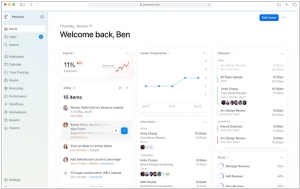Top 10 CMS systems for business websites
November 29, 2024 | Editor: Sandeep Sharma
22
Website and headless content management systems (CMS) that allow to quickly create a business website on your own hosting account and manage enterprise web content.
1
WordPress is web software you can use to create a beautiful website or blog. We like to say that WordPress is both free and priceless at the same time. The core software is built by hundreds of community volunteers, and when you’re ready for more there are thousands of plugins and themes available to transform your site into almost anything you can imagine.
2
Drupal is a free and open-source content management system (CMS) and content management framework (CMF) written in PHP and distributed under the GNU General Public License. Because of its plug-in extensibility and modular design, Drupal is sometimes described as a content management framework.
3
A powerhouse combo for your content and digital asset management needs. Get personalized, content-led experiences into market faster with Adobe Experience Manager, which combines digital asset management with the power of a content management system.
4
Sitecore Experience Platform is a powerful content management system (CMS) that combines customer data, analytics, AI, and marketing automation capabilities to nurture customers throughout their journey with personalized content in real-time, across any channel.
5
Umbraco is the leading open-source ASP.NET Core CMS. Fully extendable, highly customizable, and user-friendly.
6
Contentful is a headless content management that allows to utilize powerful orchestration of your content and tools across brands, teams, and for your commerce and marketing channels. Supports API-driven content delivery for seamless integration with various platforms.
7
Strapi is the next-gen headless CMS, open-source, javascript, enabling content-rich experiences to be created, managed and exposed to any digital device.
8
Kentico is the only fully integrated ASP.NET CMS, E-commerce, and Online Marketing platform that allows you to create cutting-edge websites, and fully optimize your digital customers’ experiences across multiple channels. Kentico saves you time and resources so you can accomplish more.
9
Creating digital experiences that transform your company takes data-driven decisions, continued experimentation and constant invention. Optimizely Digital Experience Platform helps you unlock your digital potential.
10
Craft is a flexible, user-friendly CMS for creating custom digital experiences on the web and beyond. Supports multi-site management from a single installation.
11
Joomla is a free and open source content management system (CMS) for publishing content on the World Wide Web and intranets and a model–view–controller (MVC) Web application framework that can also be used independently.
12
Liferay Digital Experience Platform is designed to work within your existing business processes and technologies to build a custom solution that uniquely meets your needs.
13
TYPO3 is a free Open Source content management system for enterprise purposes on the web and in intranets. It offers full flexibility and extendability while featuring an accomplished set of ready-made interfaces, functions and modules.
14
osCommerce (“open source Commerce”) is an e-commerce and online store-management software program. It can be used on any web server that has PHP and MySQL installed. It is available as free software under the GNU General Public License. Provides a wide range of add-ons for extended functionality and customization.
15
A Unified Platform for Content, Community and Commerce. Acquia's open cloud platform delivers scalability, security, and high performance for your Drupal sites. Acquia Cloud is the only solution that helps everyone from professional developers to large enterprises achieve success in Drupal application lifecycle management.
16
Plone is a free and open source content management system built on top of the Zope application server. In principle, Plone can be used for any kind of website, including blogs, internet sites, webshops and internal websites. It is also well positioned to be used as a document publishing system and groupware collaboration tool. The strengths of Plone are its flexible and adaptable workflow, very good security, extensibility, high usability and flexibility.
17
October is a self-hosted content management system (CMS) based on the PHP programming language and Laravel web application framework. It supports MySQL, SQLite and PostgreSQL for the database backend and uses a flat file database for the front end structure.
18
DotNetNuke is a Web Content Management Platform (or CMS) for Microsoft ASP.NET, powering over 700,000 production web sites worldwide. The flexible DotNetNuke open source CMS platform also functions as a web application development framework. Depending on your role within your organization, DotNetNuke provides powerful benefits to support your Web initiatives.
19
Magnolia CMS is an Open Source Enterprise Content Management System, Based on Best-of-Breed Java Technology And Open Standards. The Open Java CMS that runs the digital presence of your organization. Manage marketing, sales and services content for a multi-channel world. Maximize the impact of every touchpoint with Magnolia CMS.
20
Salesforce Experience Cloud allows to build customer journeys on a powerful digital experience platform, create secure websites, portals, and apps with connected data — fast.
21
Dotcms is an Open Source Content Management System (CMS), built on leading Java technology and open standards. Take the worry out of hosting your own Content Management System (CMS). DotCMS Cloud allows you to get started quickly and scale rapidly to meet your sites' growth. Allowing you to focus on what matters most, your business.
22
OpenCms is open source content management system (CMS) based on Java and XML for public internet website, extranet or intranet. OpenCms helps content managers worldwide to create and maintain beautiful websites fast and efficiently. The fully browser based user interface features configurable editors for structured content with well defined fields. A sophisticated template engine enforces a site-wide corporate layout and W3C standard compliance for all content.
23
The world’s most flexible & secure open source CMS. Combining a thriving developer community with best-in-class support, ExpressionEngine is mission control for your website’s content. Includes a powerful template engine with built-in caching for performance.
24
Open and extendable, Jahia provides a customer data driven content platform to grow your digital business through engaging customer experiences across your entire application ecosystem.
25
Create an intranet with authenticated access to core applications to improve employee productivity and training and help them get their work done. Help customers get secure, personalized access to their accounts and self-service options, and reduce service costs. Improve the secure exchange of information and applications with suppliers and partners.
Important news about CMS systems for business websites
2024. Automattic launches an AI writing assistant for WordPress
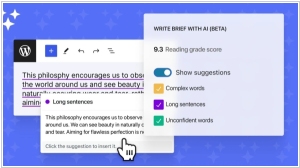
In a digital galaxy not so far away, Automattic, the cosmic custodian of WordPress, has introduced “Write Brief with AI,” a shiny new contraption that promises to help bloggers write with the clarity of a supercomputer and the brevity of a haiku-loving Vogon. Building on last year’s generative AI assistant, this nifty little tool responds to text-based prompts like a well-trained pet and can even adjust your tone to be more informal or empathetic—because, let’s face it, who doesn’t want an AI that understands feelings? Joining the ever-expanding league of AI writing assistants from the likes of Proton and Google, “Write Brief with AI” has now entered the beta phase, available to WordPress.com users via Jetpack. You’ll find it lurking under the Jetpack icon in the editor, waiting to transform your blogging experience, assuming you’re one of the fortunate inhabitants of WordPress.com.
2022. Storyblok raises $47M to build out its headless CMS
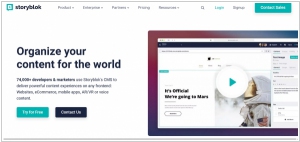
In the unassuming corner of the digital cosmos, where content meets chaos, lies Storyblok, a startup with a headless CMS so clever it seems to have spontaneously evolved to cater to both the technical wizards of code and the non-technical dreamers of marketing fluff. It’s the sort of platform designed to handle everything from managing the ever-hungry beast of website updates to orchestrating side-quests in games and shoehorning ads into apps with seamless finesse. With a cosmic injection of $47 million in funding, Storyblok plans to grow ever more feature-laden, a sort of Swiss Army knife for digital publishers, from educators to gamers to commerce titans. And with 74,000 companies (including such galactic heavyweights as Netflix, Adidas, T-Mobile, Happy Socks, and Deliveroo) using it to build 120,000 projects, one can only assume it’s quietly building its own empire of interdimensional content—a task far more organized than your average Vogon poetry recital.
2020. Contentful raises $80M for its headless CMS
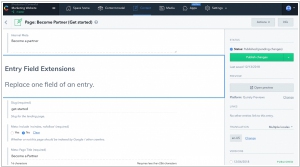
In a move that could only be described as improbably splendid, the headless CMS aficionados over at Contentful have conjured up an $80 million Series E funding round—no small feat for a company dedicated to banishing the tyranny of bloated content management systems. Astonishingly, 28% of the Fortune 500 (a rather formidable crowd) rely on Contentful to keep their content gracefully distributed across the vast and bewildering digital expanse. With a stout-hearted 2,200 paying customers, their roster includes such luminaries as Spotify, ITV, the British Museum, Telus, and Urban Outfitters—proving that even the most discerning institutions can’t resist a bit of clever content management wizardry.
2019. Ghost CMS adds SaaS subscription
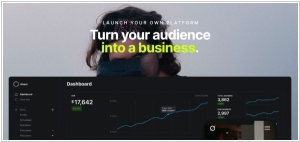
Ghost, the open-source CMS that has been around for a few years, is introducing subscription features as part of Ghost 3.0. These features will be available in both the open-source, self-hosted version and the organization’s paid, hosted SaaS product. Ghost 3.0 enables publishers to integrate the CMS directly with Stripe, which handles credit card transactions and Apple Pay out of the box. Interestingly — and something CEO John O’Nolan emphasized to me — Ghost will not impose an additional transaction fee (though Stripe’s standard fees still apply). This represents a significant difference from some of its competitors, which charge 10% or more of a publisher’s revenue as part of their business model.
2018. dotCMS Launches dotCMS 5.0 – Developed with ‘NoCode’ Philosophy
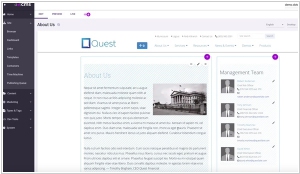
In a universe not so far away, dotCMS—a renowned purveyor of open-source Java wizardry and custodian of Customer Experience Management—has triumphantly unveiled the dazzling dotCMS 5.0. This latest incarnation is bedecked with splendid UI/UX enhancements designed to elevate the authoring experience to unprecedented heights, complete with a freshly polished Edit Mode, state-of-the-art reporting capabilities, and fortified defenses against the nefarious forces of search and security threats. Layouts are now so conveniently tethered to their pages that making changes feels less like a chore and more like a delightful stroll through a digital garden. The all-new Workflow Builder, a veritable playground of possibilities, now permits multiple workflow schemes per content type, while the Content Type Builder lets you drag and drop fields with the ease of a skilled magician pulling rabbits from hats. Adding rows, columns, and reshuffling the order of fields transforms the once Herculean task of crafting new content types—especially forms—into a merry jig. Usability has taken a leap into the cosmos; containers can now frolic freely on the same page, drastically reducing the need for an army of templates and simplifying the management of templates, layouts, and containers alike. And just when you thought it couldn’t get any better, dotCMS 5.0 introduces a shiny new reporting module that cozies up with Google Analytics, offering businesses a crystal-clear view of their web domains right from the dotCMS Dashboard. Here, the visualization of your digital kingdom can be tailored to highlight the insights that matter most to your enterprise, turning data into a symphony of meaningful revelations.
2016. Kentico CMS released cloud version
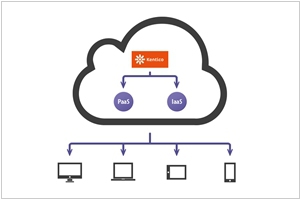
In the sprawling cosmos of digital content management, where platforms float about like hyperintelligent shades of blue, Kentico decided to shake things up with the audacious launch of Kentico Cloud, an "API-first," multi-tenant SaaS offering that practically winks at you as it goes by. This shiny trifecta includes Kentico Draft, a serene place for scribblers to scribble; Kentico Deliver, which whisks your content across the ether via API; and Kentico Engage, a cunning tool designed to coax your marketing and experiences into behaving optimally. Each piece can be licensed solo or as part of the whole package, with pricing that scales from "free for the faintest whiff of a startup" (no credit card needed!) to "you might want to check with your finance department."
2016. E-commerce platform BloomReach acquired Hippo CMS
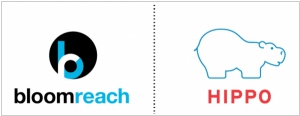
In a galaxy not terribly far away, BloomReach, the delightfully clever AI-driven e-commerce personalization platform, decided it simply couldn’t resist acquiring the rather brilliant Hippo, an open-source marvel of enterprise content management. BloomReach, known for conjuring up a singularly unified personalization platform that makes consumers feel warm and fuzzy while businesses cheer with glee, found a kindred spirit in Hippo. Once a humble web content management tool, Hippo had evolved into a digital experience virtuoso, analyzing visitors—both shy and boldly anonymous—with impressive flair. Now, armed with BloomReach’s machine-learning wizardry and Hippo’s Java-based CMS wizard hat, the duo aims to craft digital experiences so tailored they’d make even Marvin the Paranoid Android crack a smile.
2016. Hippo released on-demand Web CMS
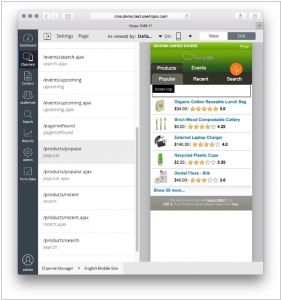
The open-source web content management provider Hippo unveiled Hippo onDemand, which is designed to transform digital business environments into adaptable and responsive digital experiences while utilizing all the advantages of the cloud. Users of the platform will have access to the complete Hippo enterprise suite with features like cross-channel and personalization in a Platform-as-a-Service (PaaS) offering, according to Sonja Kotrotsos, Hippo’s Director of Product Marketing. What concerns enterprises with cloud CMS platforms? Hippo representatives noted that companies deploying cloud-based platforms often face time-consuming custom builds or complex workarounds for rigid platforms. Hippo onDemand is a ready-to-use cloud solution that provides build freedom and flexibility through an open REST API-driven microservices architecture. It supports integration with third-party data and business solutions and scales to accommodate cross-channel expansion, according to company officials.
2016. WordPress.com turned on HTTPS encryption for all sites
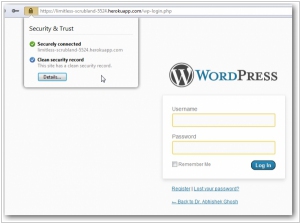
In the infinitely improbable universe of digital publishing, WordPress.com has, with a casual flick of its intergalactic wand, bestowed HTTPS upon all its sites. Yes, without lifting a finger (or, indeed, knowing where your fingers are), every site now boasts a shiny SSL certificate, proudly parading a green lock in the address bar like a Vogon with a poetry award. As an added bonus—because the universe does like to show off occasionally—Google, that cosmic arbiter of search rankings, is inclined to elevate your HTTPS-enabled site above the sad, unencrypted rabble. So, not only are you secure, but you’re also better looking to the all-seeing eye of the search engine. Cheers!
2016. Distributed content management system Contentstack launched of a set of mobile SDKs
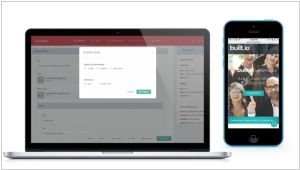
In a universe not entirely unlike our own, where Built.io Contentstack roams the digital planes, daring to take on WordPress, Drupal, and any other looming titans of the CMS empire, a bold new update has arrived to disrupt the galactic content order. With its shiny new mobile SDKs for both Android and iOS, along with a spruced-up interface for the delight of developers and content editors alike, Built.io Contentstack emerges once again as the hero we didn’t know we needed. The concept, you see, is wonderfully headless—no bulky CMS dictating how content should look or behave; instead, this CMS lives in pure content creation nirvana. From here, developers are free to whisk this liberated data to any platform imaginable, untethered by the usual constraints of presentation. And thus, in this very headless fashion, Built.io Contentstack strides confidently into the enterprise CMS cosmos.



























